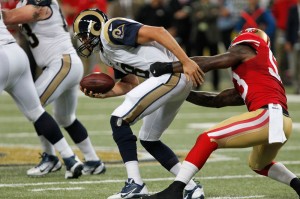Football
Rams, Wash. U. need effective running game to taste victory
St. Louis Rams quarterback Sam Bradford (8) is sacked by the San Francisco 49ers’ NaVorro Bowmano n Thursday, September 26, 2013, at the Edward Jones Dome in St. Louis, Missouri. The 49ers won, 35-11.
The blowout loss to San Francisco was the unit’s worst showing yet: St. Louis totaled just 18 rushing yards on 19 attempts in the defeat, and the team had only one run go for longer than four yards—a seven-yard scamper by backup Benny Cunningham in garbage time. For comparison, both Frank Gore and Kendall Hunter of the 49ers needed only one touchdown run to gain more than 18 yards each.
“I don’t think we did a good enough job of finishing runs like we should have,” Cunningham said. “As a unit, we can run more physical with the football and kind of help out the offense much more than we’re doing now.”
“That’s pretty much the issue we’re facing right now because everything spins off of that—our inability to run the football, basically, and then get[ting] behind compounds it,” head coach Jeff Fisher observed.
Starting late in the second quarter and continuing through the start of the fourth, the Rams punted on six straight drives of four plays or fewer, repeatedly sending the punting unit back onto the field and not granting a tired defense any rest before having to return to face the 49ers’ potent rushing attack.
“It just seems like we never really found a rhythm,” quarterback Sam Bradford said. “When you go three-and-out, three-and-out, three-and-out, it’s almost impossible to start a rhythm on offense.”
Across town at Washington University, the school’s Division III football team has also struggled to generate offensive flow. Against No. 9 Wisconsin-Whitewater in the season opener, for instance, the Bears scored an early touchdown but couldn’t pull off the upset partly because of a second-half drought in which they failed to record a single first down on eight straight possessions.
In beating Centre College 31-14 Saturday, though, Wash. U. had its best offensive output of the season. “Our offense clicked and started putting things together well,” junior linebacker Fade Oluokun said. “They finished drives and got first downs.”
Senior quarterback Eric Daginella attributed this success partly to the running game, through which the Bears gained 165 yards and three touchdowns. The offensive line “made a huge difference for us and helped run the ball. That was a key difference for us,” he said.
For the 2-2 Bears, the formula has been quite simple this season: run well and win; run poorly and lose. The team has averaged 172 rushing yards (3.9 per carry) in its wins compared to 58 (2.4 per rush) in the losses.
In the NFL, similarly, an inability to run the ball well correlates with losing; teams averaging fewer than 70 rushing yards per game have a combined record of 1-15 this season. Among that substandard group are the Rams, who rank 31st out of 32 teams in the NFL in both yards per carry (2.6) and rushing yards per game (47.3) and are also one of only four squads without a rushing touchdown. Starting running back Daryl Richardson sits second-to-last among qualified backs in both yards per carry (2.7) and longest rush (only 10 yards).
But after scoring only one touchdown against the 49ers, Bradford wasn’t putting the blame solely on the running game.
“Obviously, the running game struggled, but every area of our offense struggled tonight,” he said. “We’re going to have to get better in all phases of the game in order to be an efficient, productive offense. It’s not just the run game; it’s the passing game and everything that this unit is doing right now. We’re not doing anything well.”
The comprehensive offensive issues are paralleled at Wash. U. Through games played on Sept. 21, the Red and Green ranked in the bottom 50 in Division III in both rushing and passing yards per game, which combine to place the Bears 230th out of 240 teams in average total yards.
Before their 31-point outburst against Centre, the Red and Green had managed only 5.7 points per game, a mark placing them behind than all but six Division III teams. Saturday’s showing doesn’t make the Bears an offensive juggernaut by any means, but it’s a step toward balance between an always-stingy defense and an offense that has struggled to pick up first downs, let alone points, at times this season.
The Rams can only hope for a similar showing as they look to erase the stench of two straight 24-point losses. Their next opponent might be perfect for the task; the Jacksonville Jaguars, the NFL’s worst team, have allowed 82 total points in the last two weeks. And after Wash. U.’s performance Saturday, the Rams might try looking to their collegiate neighbors for a strategy lesson.
With additional reporting by Derek Shyr.

